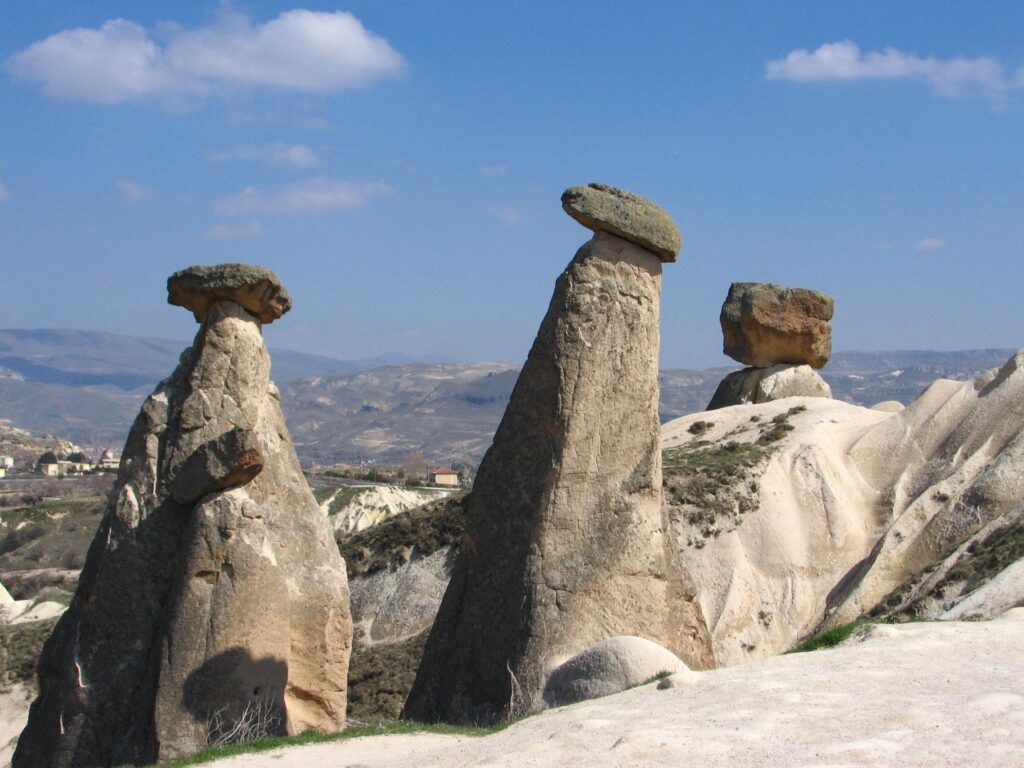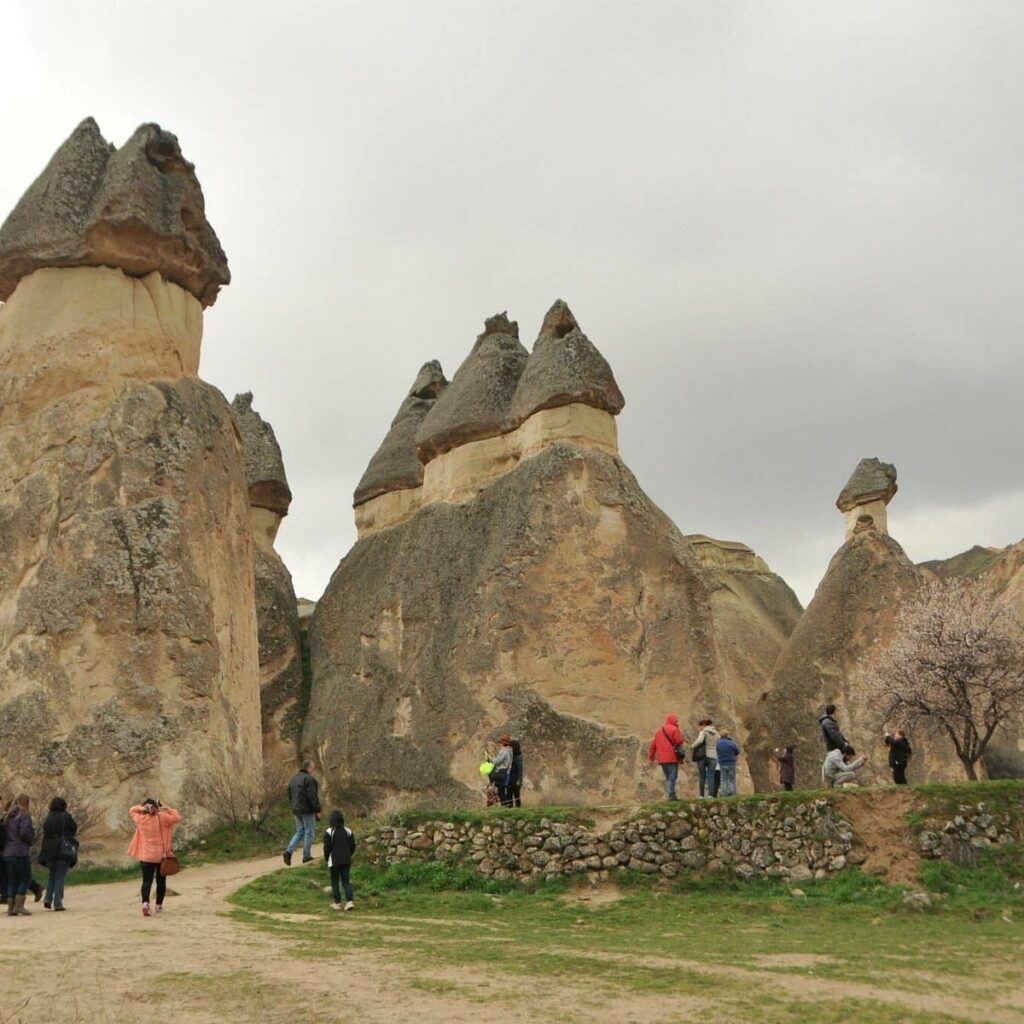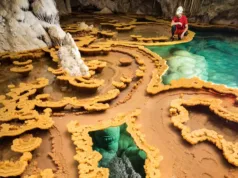The Fairy Chimneys of Turkey, also known as hoodoos, are one of the most striking natural landmarks in the world. These unique geological formations are predominantly found in the Cappadocia region of central Turkey, an area renowned for its otherworldly landscapes, rich history, and cultural significance.

Fairy Chimneys are tall, thin spires of rock that protrude from the bottom of an arid basin or badland. They are formed through a geological process that involves the erosion of sedimentary rocks by water and wind. The softer rock erodes more quickly than the harder capstone, which is often composed of basalt or andesite. This differential erosion process leaves behind the distinctive pillar-like shapes that tower high above the surrounding landscape.
Geographic Location in Cappadocia, Turkey
Cappadocia, where these formations are most prominently found, is situated in the central part of Turkey. This region is characterized by its dramatic vistas, including deep valleys and soaring rock formations, among which the Fairy Chimneys stand out. Cappadocia’s unique terrain has not only shaped its natural environment but also its human history. The soft rocks led ancient civilizations to carve out houses, churches, and even entire underground cities directly from the rock, making the cultural landscape as fascinating as the geological one.
Visitors to Cappadocia can explore these formations and the rich history intertwined with them, contributing to the area’s popularity as a major tourist destination in Turkey.
Geological Formation

The Fairy Chimneys of Cappadocia in Turkey are a fascinating example of the interplay between geological processes and the environment, leading to the creation of unique natural sculptures. Understanding their formation involves examining the types of rocks involved, their characteristics, and the critical role of erosion.
Geological Processes
The formation of the Fairy Chimneys began millions of years ago during the Tertiary period. This era was marked by intense volcanic activity in the region, which resulted in the deposition of thick layers of tuff (a soft volcanic ash solidified into rock) and overlaying this with harder rocks such as basalt and andesite. Over time, these layers were subjected to natural forces that shaped their present form.
Types of Rocks and Their Characteristics
- Tuff: The primary material forming the base of the Fairy Chimneys is tuff, which is relatively soft and easy to carve. Tuff results from volcanic ash and debris that have settled and compacted over time. Its softness makes it highly susceptible to erosion, which has played a significant role in shaping the chimneys.
- Basalt and Andesite: These harder rocks form the capstones of the Fairy Chimneys. Basalt and andesite are both volcanic rocks, but basalt is typically darker and denser, while andesite can have a variable composition. These rocks are much more resistant to erosion than tuff, which helps protect the underlying softer tuff from eroding too quickly.
Role of Erosion in Shaping the Fairy Chimneys

Erosion is the driving force behind the sculpting of the Fairy Chimneys. The process begins with water seeping into cracks and crevices in the rock. In winter, the water freezes and expands, widening the cracks (a process known as frost wedging). Additionally, wind erosion carries away smaller particles of the softer tuff, further shaping the formations.
As the softer tuff erodes away, the more resistant basalt and andesite capstones help to protect the columns of tuff beneath them. This differential erosion results in the tall, pillar-like structures with the harder rock sitting atop them, characteristic of the Fairy Chimneys. Over centuries, this process has sculpted the vast and striking landscape that draws visitors from around the world to Cappadocia.
Overall, the creation of the Fairy Chimneys is a prime example of how geological processes and the environment interact to create natural wonders, with erosion playing a pivotal role in their ongoing formation and evolution.
Historical and Cultural Significance

The Fairy Chimneys of Cappadocia hold profound historical and cultural significance, reflecting the unique interplay between nature and human civilization in the region. This area, characterized by its striking geological formations, has been a cradle of history, culture, and art for millennia.
Historical Significance
The region of Cappadocia, including the Fairy Chimneys, has been inhabited since at least the Bronze Age. It was a crucial area in the Hittite Empire and later saw influences from various other civilizations including Phrygians, Persians, Romans, and Byzantines. Each of these groups left their mark on the landscape, not only through the relics and artifacts found in the area but also through their adaptation to the geological features.
The soft tuff rock of the Fairy Chimneys proved to be an excellent material for carving, which led to the creation of extensive underground cities, dwellings, churches, and monasteries directly into the rock formations. These structures provided safety and seclusion, especially for early Christian communities during Roman persecutions.
Cultural Significance
Culturally, Cappadocia is a testament to the resilience and creativity of its inhabitants. The rock-hewn churches, decorated with frescoes, are particularly notable. These frescoes, which date from as early as the 7th century, display a range of iconographic and stylistic influences and are an invaluable part of Byzantine art history.
The way of life adapted to the landscape also signifies a unique cultural evolution. The underground cities, such as Derinkuyu and Kaymaklı, could house thousands of people and were equipped with ventilation shafts, chapels, and wine presses, showcasing a sophisticated use of space and resources.
Continuing Tradition
Today, Cappadocia is not only a major tourist destination but also a vibrant living community. Traditional pottery and carpet weaving, along with the ongoing use of cave dwellings as homes, hotels, and restaurants, continue the cultural traditions of the region. The annual hot air balloon flights over the Fairy Chimneys have become iconic, blending the ancient and modern allure of Cappadocia.
The Fairy Chimneys of Cappadocia, therefore, are much more than natural wonders. They are a deeply ingrained part of Turkey’s cultural heritage, representing centuries of human endeavor, spiritual significance, and artistic expression, all intertwined with the spectacular natural environment.




































